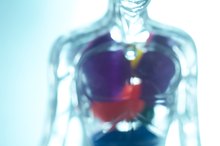What Are the Last Stages of Liver Failure?
The last stage of liver failure, cirrhosis, usually develops over a number of years-- although acute liver failure can occur. Cirrhosis can be compensated--meaning that the liver retains enough function to perform vital processes--or uncompensated, meaning that the liver can no longer carry out normal functions. About 75 percent of the liver must be destroyed before it becomes nonfunctioning, Sharing in Health reports 3. Cirrhosis is the third most common cause of death in people ages 45 to 65, the Merck Manual states 1.
If you are experiencing serious medical symptoms, seek emergency treatment immediately.
Causes
Alcohol abuse is the most common cause of cirrhosis, but hepatitis and non-alcoholic steatohepatitis--which often affects obese people--and metabolic diseases also cause cirrhosis. Hepatitis C more often results in end-stage liver failure than hepatitis B in the United States, the Merck Manual says 1. Other metabolic diseases that lead to chronic end-stage liver failure include primary biliary cholangitis, cystic fibrosis, Wilson disease and hematochromatosis 3. Acute liver failure can occur from severe infection or overdose of medications toxic to the liver, such as acetaminophen.
Symptoms
Hepatic Encephalopathy Low-Protein Diet
Learn More
Breasts may enlarge and testes shrink in men due to the body’s inability to break down estrogen. Complications of decompensated cirrhosis include fluid accumulation in the abdomen called ascites, dilated blood vessels in the esophagus and stomach that can rupture and bleed heavily and encephalopathy, which is problems with thinking and memory. Kidney failure can also complicate end-stage liver disease.
Diagnosis
Imaging studies of the liver such as ultrasound, computed tomography or magnetic resonance imaging plus medical history and review of symptoms makes diagnosis of end-stage liver disease straightforward. Biopsy, removal of a piece of liver tissue, reveals the degree of fibrosis and scarring.
Treatment
3 Stages of Liver Disease
Learn More
There’s no cure and no treatment to reverse the damage of cirrhosis once it occurs, except for live transplantation. Avoiding substances that harm the liver, such as alcohol, may arrest compensated cirrhosis, but once uncompensated cirrhosis occurs, death will ensue unless the person receives a new liver.
Reducing complications can prolong life; beta blockers reduce high pressure in portal hypertension, which causes varices. Lactulose improves encephalopathy by increasing the number of stools per day. Diuretics help reduce the fluid buildup in ascites. Paracentesis, removal of fluid with a needle, plus antibiotic therapy decreases the chance of infection in the fluid, called spontaneous bacterial peritonitis. Dialysis may be necessary if kidney failure occurs.
- There’s no cure and no treatment to reverse the damage of cirrhosis once it occurs, except for live transplantation.
- Paracentesis, removal of fluid with a needle, plus antibiotic therapy decreases the chance of infection in the fluid, called spontaneous bacterial peritonitis.
Complications
In addition to complications of decompensation such as ascites and encephalopathy, liver cancer can develop in people with end-stage liver disease--particularly in those whose disease was caused by alcohol or hepatitis. Though a liver transplant is a positive step, there are fewer livers available than people waiting, and inevitably some people die without receiving a liver. Some complications preclude being offered a liver, such as advanced liver cancer or serious heart disease. In most transplant centers, abstinence from alcohol for at least six months is essential to be placed on the transplant list, the Merck Manual reports 1.
- In addition to complications of decompensation such as ascites and encephalopathy, liver cancer can develop in people with end-stage liver disease--particularly in those whose disease was caused by alcohol or hepatitis.
Related Articles
References
- Merck Manual: Cirrhosis
- Sharing in Health: Chronic Liver Disease
- "American Family Physician": Cirrhosis and Chronic Liver Failure; Joel Heidelbaugh, M.D. Septemeber 2006
- Centers for Disease Control and Prevention (CDC). National Vital Statistics Report, Volume 67, Number 5. https://www.cdc.gov/nchs/data/nvsr/nvsr67/nvsr67_05.pdf. Published July 26, 2018.
- National Institute of Diabetes and Digestive and Kidney Diseases. Cirrhosis. https://www.niddk.nih.gov/health-information/liver-disease/cirrhosis#signs
- FastStats - Chronic Liver Disease or Cirrhosis. Centers for Disease Control and Prevention. May 30, 2013.
- Guss D, Sherigar J, Mohanty SR. Missed Diagnosis of Liver Cirrhosis Leads to Disparities in Care for Older Patients. Gastroenterology Res. 2018;11(5):333-339. doi:10.14740/gr1074w
- Symptoms & Causes of Cirrhosis. National Institute of Diabetes and Digestive and Kidney Diseases. Mar 1, 2018.
- Cirrhosis: MedlinePlus Medical Encyclopedia. MedlinePlus. Sept 11, 2019.
- Cirrhosis: MedlinePlus Medical Encyclopedia. MedlinePlus. Sept 11, 2019.
- Nderitu P, Bosco C, Garmo H, et al. The association between individual metabolic syndrome components, primary liver cancer and cirrhosis: A study in the Swedish AMORIS cohort. Int J Cancer. 2017;141(6):1148-1160. doi:10.1002/ijc.30818
- Hung TH, Liang CM, Hsu CN, et al. Association between complicated liver cirrhosis and the risk of hepatocellular carcinoma in Taiwan. PLoS ONE. 2017;12(7):e0181858. doi:10.1371/journal.pone.0181858
- Cirrhosis of the Liver Prevention. Cleveland Clinic. Jan 11, 2019.
- Centers for Disease Control and Prevention (CDC). National Vital Statistics Report, Volume 67, Number 5. Published July 26, 2018.
- National Institute of Diabetes and Digestive and Kidney Diseases. Cirrhosis.
Writer Bio
A registered nurse with more than 25 years of experience in oncology, labor/delivery, neonatal intensive care, infertility and ophthalmology, Sharon Perkins has also coauthored and edited numerous health books for the Wiley "Dummies" series. Perkins also has extensive experience working in home health with medically fragile pediatric patients.







